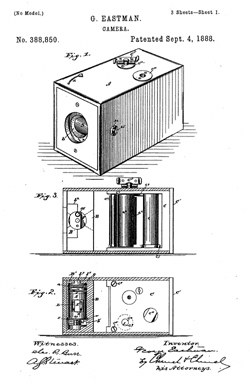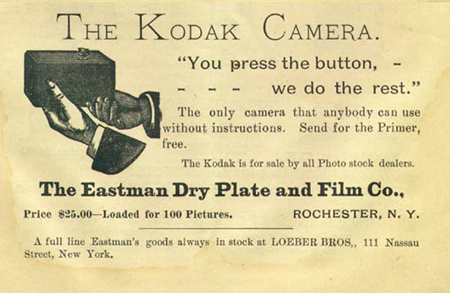 On September 4, 1888, George Eastman received patent #388,850 for a roll film camera. The camera called the”Kodak” was the beginning of snapshot photography. The ease of using this camera and its relatively inexpensive price of $25 dollars appealed to the middle class.
On September 4, 1888, George Eastman received patent #388,850 for a roll film camera. The camera called the”Kodak” was the beginning of snapshot photography. The ease of using this camera and its relatively inexpensive price of $25 dollars appealed to the middle class.
The orginal Kodak camera was small and light enough to be held by hand. This very simple camera leather covered box had no view finder, a wide angle lens allowing for good depth of field, a single shutter speed of 1/25th of a second, a shutter release and a tripod mount placed on the top of the camera. Taking a picture with this camera was a simple process which required only three steps: turning the key to wind on the film; pulling the string to set the shutter; and pressing the button to take the photograph. The Kodak camera really was the first point and shoot.

“You press the button, we do the rest” was the first marketing slogan of Kodak. That was exactly how the first Kodak camera worked. The camera was preloaded with enough film for 100 shoots. When all the film was exposed , the entire camera was sent back to the Kodak Company on Rochester, NY. For $10, the film was developed. 2.5 inch circular prints were made to compensate for the poor image quality in the corners. Then the camera was reloaded with film and the prints were sent back to the customer.
Over 5,000 of these revolutionary cameras were sold changing the way people viewed photography.
